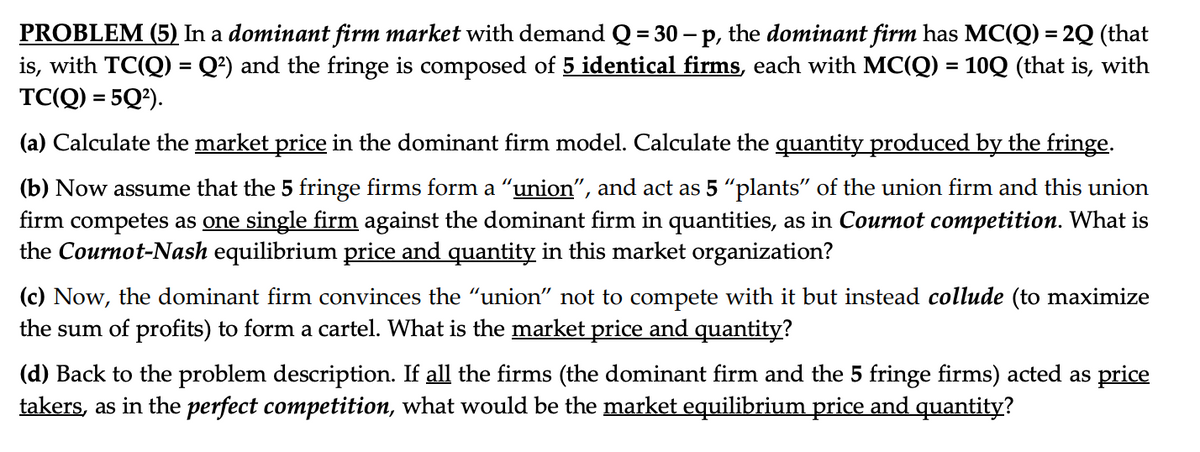PROBLEM (5) In a dominant firm market with demand Q = 30 - p, the dominant firm has MC(Q) = 2Q (that is, with TC(Q) = Q²) and the fringe is composed of 5 identical firms, each with MC(Q) = 10Q (that is, with TC(Q)=5Q²). (a) Calculate the market price in the dominant firm model. Calculate the quantity produced by the fringe. (b) Now assume that the 5 fringe firms form a "union", and act as 5 "plants" of the union firm and this union firm competes as one single firm against the dominant firm in quantities, as in Cournot competition. What is the Cournot-Nash equilibrium price and quantity in this market organization? (c) Now, the dominant firm convinces the "union" not to compete with it but instead collude (to maximize the sum of profits) to form a cartel. What is the market price and quantity? (d) Back to the problem description. If all the firms (the dominant firm and the 5 fringe firms) acted as price takers, as in the perfect competition, what would be the market equilibrium price and quantity?
PROBLEM (5) In a dominant firm market with demand Q = 30 - p, the dominant firm has MC(Q) = 2Q (that is, with TC(Q) = Q²) and the fringe is composed of 5 identical firms, each with MC(Q) = 10Q (that is, with TC(Q)=5Q²). (a) Calculate the market price in the dominant firm model. Calculate the quantity produced by the fringe. (b) Now assume that the 5 fringe firms form a "union", and act as 5 "plants" of the union firm and this union firm competes as one single firm against the dominant firm in quantities, as in Cournot competition. What is the Cournot-Nash equilibrium price and quantity in this market organization? (c) Now, the dominant firm convinces the "union" not to compete with it but instead collude (to maximize the sum of profits) to form a cartel. What is the market price and quantity? (d) Back to the problem description. If all the firms (the dominant firm and the 5 fringe firms) acted as price takers, as in the perfect competition, what would be the market equilibrium price and quantity?
Managerial Economics: Applications, Strategies and Tactics (MindTap Course List)
14th Edition
ISBN:9781305506381
Author:James R. McGuigan, R. Charles Moyer, Frederick H.deB. Harris
Publisher:James R. McGuigan, R. Charles Moyer, Frederick H.deB. Harris
Chapter13: best-practice Tactics: Game Theory
Section: Chapter Questions
Problem 1E
Related questions
Question
Please answer each part step by step with the solution.

Transcribed Image Text:PROBLEM (5) In a dominant firm market with demand Q = 30 - p, the dominant firm has MC(Q) = 2Q (that
is, with TC(Q) = Q²) and the fringe is composed of 5 identical firms, each with MC(Q) = 10Q (that is, with
TC(Q) = 5Q²).
(a) Calculate the market price in the dominant firm model. Calculate the quantity produced by the fringe.
(b) Now assume that the 5 fringe firms form a "union", and act as 5 "plants" of the union firm and this union
firm competes as one single firm against the dominant firm in quantities, as in Cournot competition. What is
the Cournot-Nash equilibrium price and quantity in this market organization?
(c) Now, the dominant firm convinces the "union" not to compete with it but instead collude (to maximize
the sum of profits) to form a cartel. What is the market price and quantity?
(d) Back to the problem description. If all the firms (the dominant firm and the 5 fringe firms) acted as price
takers, as in the perfect competition, what would be the market equilibrium price and quantity?
Expert Solution
This question has been solved!
Explore an expertly crafted, step-by-step solution for a thorough understanding of key concepts.
This is a popular solution!
Step 1: State the given information
VIEWStep 2: a) Calculate the market price in the dominant firm model & quantity produced by fringe
VIEWStep 3: b) Determine the Cournot-Nash equilibrium price and quantity
VIEWStep 4: c) Calculate the price and quantity if both firms collude
VIEWStep 5: d) Find market equilibrium price and quantity assuming perfect competition
VIEWSolution
VIEWTrending now
This is a popular solution!
Step by step
Solved in 6 steps with 11 images

Knowledge Booster
Learn more about
Need a deep-dive on the concept behind this application? Look no further. Learn more about this topic, economics and related others by exploring similar questions and additional content below.Recommended textbooks for you

Managerial Economics: Applications, Strategies an…
Economics
ISBN:
9781305506381
Author:
James R. McGuigan, R. Charles Moyer, Frederick H.deB. Harris
Publisher:
Cengage Learning

Managerial Economics: Applications, Strategies an…
Economics
ISBN:
9781305506381
Author:
James R. McGuigan, R. Charles Moyer, Frederick H.deB. Harris
Publisher:
Cengage Learning